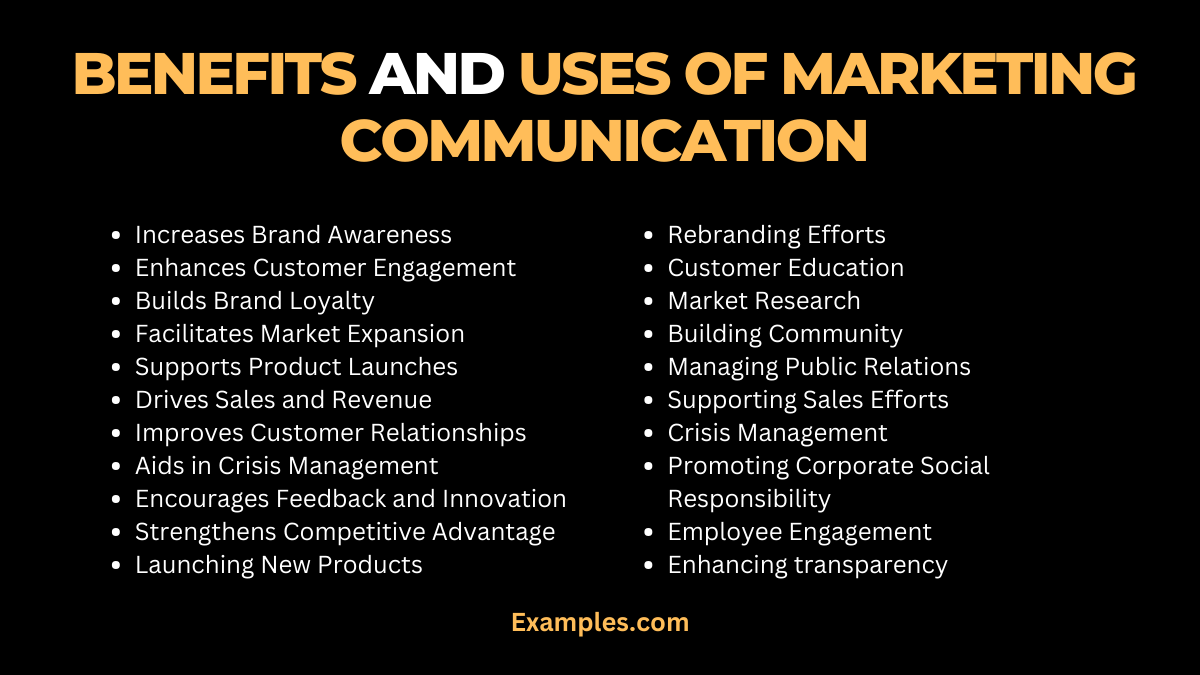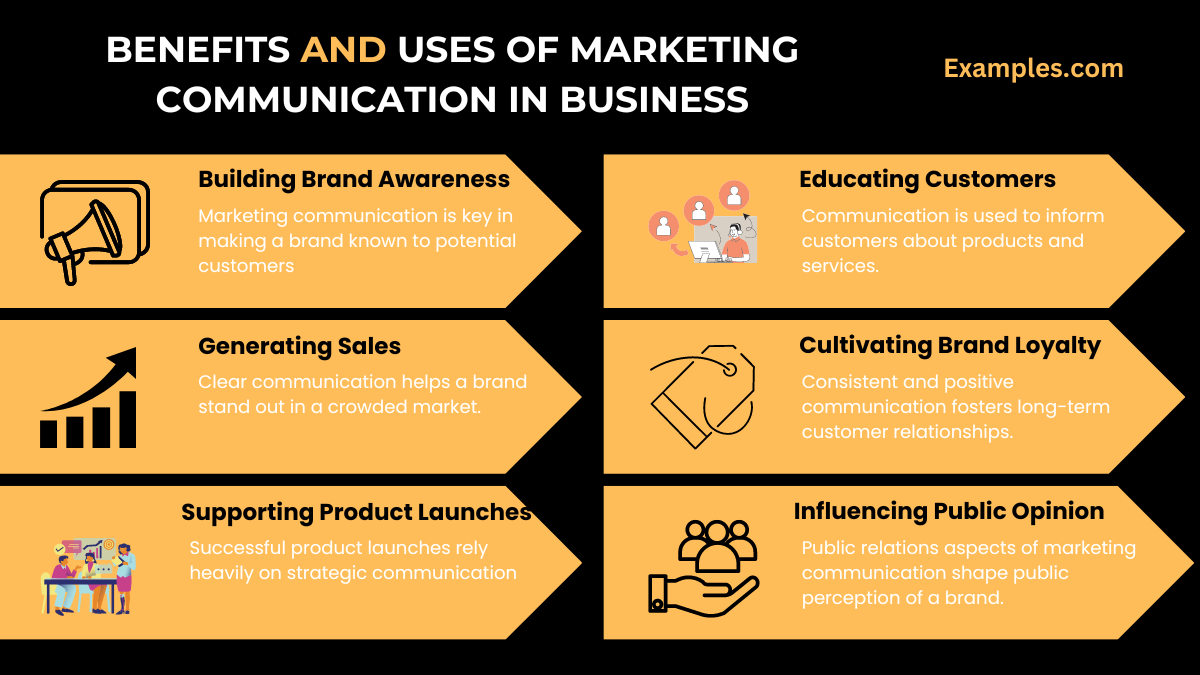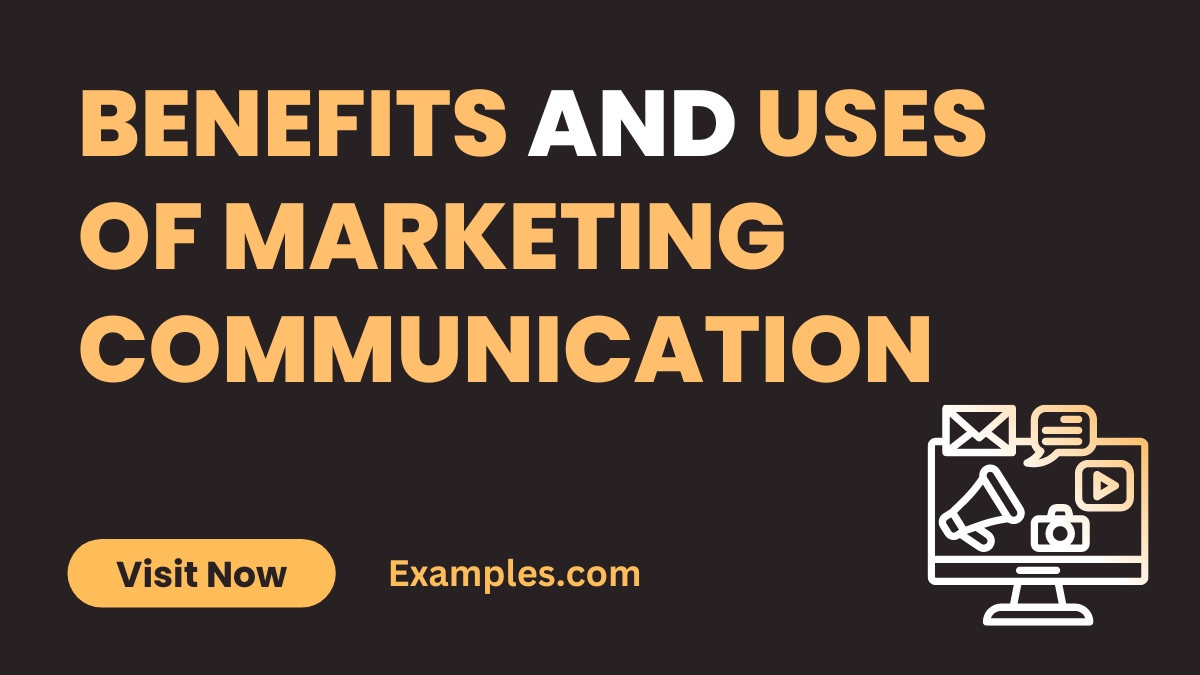Benefits and Uses of Marketing Communication – Examples, Benefits
Marketing communication plays a pivotal role in the success of a business, serving as a bridge between the company and its customers. This comprehensive guide delves into the numerous benefits and uses of marketing communication, illustrated with practical marketing communication examples. Discover how effective communication strategies can enhance brand awareness, foster customer loyalty, and drive sales. From traditional advertising to digital marketing, this guide offers valuable insights for businesses aiming to strengthen their market presence through targeted, impactful communication.
10 Benefits of Marketing Communication

- Increases Brand Awareness: Effective marketing communication amplifies brand visibility and recognition.
Example: Apple’s iconic product announcements have made it a household name. - Enhances Customer Engagement: Keeps customers involved and interested in the brand.
Example: Starbucks’ interactive social media campaigns create a strong customer community. - Builds Brand Loyalty: Consistent and positive communication fosters customer loyalty.
Example: Amazon’s customer-centric communication has cultivated a loyal customer base. - Facilitates Market Expansion: Helps in reaching new markets and demographics.
Example: Nike’s global marketing campaigns have expanded its market reach. - Supports Product Launches: Communication is key to successful new product introductions.
Example: Samsung’s strategic product launch communications have been crucial in its market success. - Drives Sales and Revenue: Directly impacts the company’s bottom line through effective promotions.
Example: McDonald’s limited-time offers generate buzz and increase sales. - Improves Customer Relationships: Establishes and maintains a positive connection with customers.
Example: Coca-Cola’s customer-focused campaigns have strengthened its customer relationships. - Aids in Crisis Management: Effective communication can mitigate the impact of negative events.
Example: Johnson & Johnson’s transparent communication during product recalls preserved customer trust. - Encourages Feedback and Innovation: Opens channels for customer feedback leading to innovation.
Example: Tesla’s incorporation of customer feedback into product development. - Strengthens Competitive Advantage: Differentiates the brand in a crowded marketplace.
Example: Google’s unique marketing communications set it apart in the tech industry.
10 Uses of Marketing Communication
- Launching New Products: Introducing new offerings to the market effectively.
Example: Apple’s launch events create excitement around new products. - Rebranding Efforts: Communicating a brand’s new image or direction.
Example: Old Spice’s rebranding campaign transformed its image to appeal to a younger audience. - Customer Education: Informing customers about product features and benefits.
Example: Adobe’s tutorials and webinars educate customers about product usage. - Market Research: Gathering consumer insights for strategic decision-making.
Example: Coca-Cola uses social media polls to gauge consumer preferences. - Building Community: Creating a sense of belonging among customers.
Example: Harley-Davidson’s marketing fosters a strong community among its customers. - Managing Public Relations: Maintaining a positive public image.
Example: Toyota’s transparent communication during recalls maintains its positive reputation. - Supporting Sales Efforts: Complementing and enhancing sales strategies.
Example: Salesforce’s targeted email campaigns support their sales process. - Crisis Management: Handling communication during challenging times.
Example: Samsung’s effective communication strategy during the Galaxy Note 7 recall. - Promoting Corporate Social Responsibility: Showcasing a company’s commitment to social and environmental causes.
Example: Ben & Jerry’s campaigns highlight their commitment to social causes. - Employee Engagement: Keeping employees informed and motivated.
Example: Google’s internal communication fosters a strong company culture among employees.
Each of these benefits and uses, with their respective examples, demonstrates the significant impact marketing communication has on a business’s success, ranging from enhancing customer engagement to strengthening market presence.
What are the Benefits of using Integrated Marketing Communications?
- Consistent Brand Messaging: Integrated marketing communications ensure a uniform message across all platforms, strengthening brand identity.
Example: Apple’s consistent messaging in its advertising, website, and store design. - Enhanced Customer Experience: A seamless communication strategy across various channels improves the customer experience.
Example: Disney’s integration of theme park experience with its mobile app, website, and marketing collateral. - Cost-Effectiveness: By harmonizing different marketing activities, businesses can reduce costs.
Example: Coca-Cola using similar visuals and themes across different media, maximizing impact while minimizing costs. - Increased Reach and Frequency: Integration allows messages to reach a wider audience more frequently.
Example: Nike’s campaigns appearing on TV, online, and in stores, increasing brand visibility. - Improved Return on Investment (ROI): Consistent and clear messaging across channels often leads to a better ROI.
Example: Procter & Gamble’s unified campaigns leading to increased sales. - Stronger Customer Relationships: Consistent and relevant messaging builds trust and loyalty among customers.
Example: Starbucks’ loyalty program integrating in-store, mobile, and digital experiences. - Better Data Collection and Analysis: Integrated approaches allow for more comprehensive data collection and analysis.
Example: Amazon’s use of customer data from its website, Alexa, and Prime Video to tailor marketing strategies. - Enhanced Internal Communication and Coordination: Promotes unity and efficiency within the organization.
Example: Google’s cohesive internal communication aligning different departments for consistent external messaging. - Adaptability to Market Changes: A unified approach allows for quicker adaptation to market shifts.
Example: Samsung’s ability to swiftly change its marketing strategies across channels in response to market trends. - Effective Target Market Penetration: Integrated communications ensure messages resonate more effectively with the target market.
Example: LinkedIn’s targeted content marketing and advertising strategy reaching professionals.
Benefits and Uses of Marketing Communication in Business

- Building Brand Awareness: Marketing communication is key in making a brand known to potential customers.
Example: Red Bull’s extreme sports events creating brand recognition. - Differentiating from Competitors: Clear communication helps a brand stand out in a crowded market.
Example: TOMS’ unique message of social responsibility differentiating it from other shoe brands. - Generating Sales: Effective communication can directly lead to increased sales.
Example: Amazon’s targeted email campaigns promoting specific products based on user behavior. - Improving Customer Engagement: Engaging content and interactions keep customers involved with the brand.
Example: Netflix’s use of social media to engage viewers with content teasers and discussions. - Supporting Product Launches: Successful product launches rely heavily on strategic communication.
Example: Apple’s carefully orchestrated announcements and marketing for new product releases. - Facilitating Direct Customer Feedback: Marketing communication channels allow businesses to gather valuable customer feedback.
Example: Starbucks’ idea platform where customers can suggest and vote on ideas. - Educating Customers: Communication is used to inform customers about products and services.
Example: Tesla’s educational content about electric vehicle technology. - Cultivating Brand Loyalty: Consistent and positive communication fosters long-term customer relationships.
Example: Sephora’s Beauty Insider program that rewards customer loyalty. - Influencing Public Opinion: Public relations aspects of marketing communication shape public perception of a brand.
Example: Patagonia’s environmental advocacy influencing public opinion about sustainability. - Mitigating Crises: Effective communication is crucial for damage control during crises.
Example: Johnson & Johnson’s response during the Tylenol tampering incident.
In conclusion, marketing communication, especially when integrated, offers substantial benefits for businesses. It enhances brand awareness, customer engagement, and loyalty while ensuring consistency and efficiency in messaging. This guide highlights the importance of strategic communication in business, providing actionable tips and real-world examples to illustrate the transformative power of effective marketing communication.



